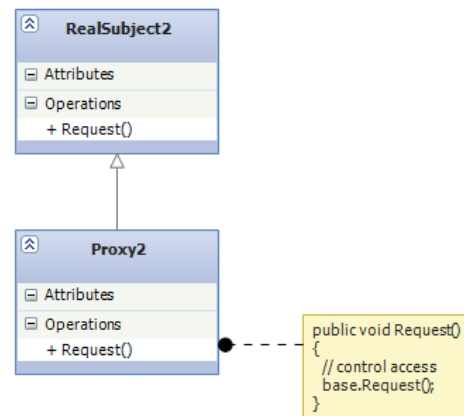Proxy Pattern
04 Mar 2019代理模式
使用场景
- remote 远程代理。为一个对象在不同地址空间提供局部代表;
- virtual 虚拟代理。对象创建的开销很大的时候,用代理去lazy loading;
- protection 安全代理。控制真实对象的访问权限,即在访问一个对象时附加一些内务处理。


lazy loading
在真正需要的时候才去loading数据,其余时候只用继承自同一基类的proxy类。在proxy类中实现需要被访问的字段数据的lazy loading property, 如:
_items = new Lazy<List<OrderDetails>>(() => new OrderDetails());
或者通过flag 字段来实现:
public override List<OrderDetails> Items
{
get
{
return GetItems();
}
}
protected override List<OrderDetails> GetItems()
{
if (!_itemsLoaded)
{
GetEntity();
_orderDetails = base.GetItems();
_itemsLoaded = true;
}
return _orderDetails;
}
A sample of protection type
此例将proxy模式加入到仓库模式中去实现cache,提升了仓库模式的性能。
CachedOrderRepository作为proxy继承自RemoteOrderRepository(连接数据库,提供数据)。CachedOrderRepository类override了父类的getData方法,并在其中附加一些内务处理(此处是运用container来实现数据缓存):
using System.Runtime.Caching;
public class CachedOrderRepository : RemoteOrderRepository
{
public override OrderEntity GetById(int id)
{
string cacheKey = "OrderEntity-" + id;
var entity = MemoryCache.Default[cacheKey] as OrderEntity;
if(entity == null)
{
entity = base.GetById(id);
var cacheItem = new CacheItem(cacheKey, entity);
var policy = new CacheItemPolicy();
MemoryCache.Default.Add(cacheItem, policy);
}
return entity;
}
}
相关模式
-
适配器模式:适配器改变对象的接口来满足客户端的需要。代理模式保留接口不变,控制访问对象底层行为。
-
装饰器模式:实现方式与代理模式很像,但是目的不同。装饰器给对象附加上责任,但是代理控制对象的访问。